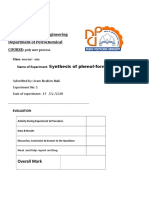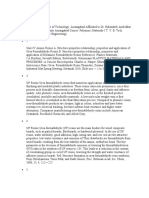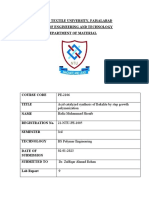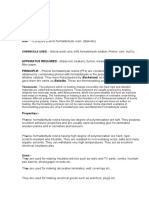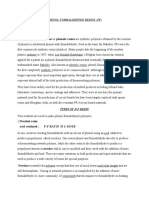Plastics Materials - J. A. Brydson - 7th Edition - Chapter 28
Plastics Materials - J. A. Brydson - 7th Edition - Chapter 28
Uploaded by
CristianeHenschelCopyright:
Available Formats
Plastics Materials - J. A. Brydson - 7th Edition - Chapter 28
Plastics Materials - J. A. Brydson - 7th Edition - Chapter 28
Uploaded by
CristianeHenschelOriginal Description:
Copyright
Available Formats
Share this document
Did you find this document useful?
Is this content inappropriate?
Copyright:
Available Formats
Plastics Materials - J. A. Brydson - 7th Edition - Chapter 28
Plastics Materials - J. A. Brydson - 7th Edition - Chapter 28
Uploaded by
CristianeHenschelCopyright:
Available Formats
28 Furan Resins
28.1
INTRODUCTION
The furan or furane resins mainly find use because of their excellent chemical and heat resistance. In the past they have mainly been used in applications peripheral to the plastics industry such as foundry resins, for chemically resistant cements and for binders. Recent developments have facilitated their use in laminates for chemical plant.
28.2
PREPARATION OF INTERMEDIATES
The two intermediates of commercial furan resins are furfural and furfuryl alcohol. Furfural occurs in the free state in many plants but is obtained commercially by degradation of hemicellulose constituents present in these plants. There are a number of cheap sources of furfural, and theoretical yields of over 20% (on a dry basis) may be obtained from both corn cobs and oat husks. In practice yields of slightly more than half these theoretical figures may be obtained. In the USA furfural is produced in large quantities by digestion of corn cobs with steam and sulphuric acid. The furfural is removed by steam distillation. Furfural is a colourless liquid which darkens in air and has a boiling point of 161.7"C at atmospheric pressure. Its principal uses are as a selective solvent used in such operations as the purification of wood resin and in the extraction of butadiene from other refinery gases. It is also used in the manufacture of phenolfurfural resins and as a raw material for the nylons. The material will resinify in the presence of acids but the product has little commercial value. Catalytic hydrogenation of furfural in the presence of copper chromite leads to furfuryl alcohol, the major intermediate of the furan resins (Figure 28.1). 810
CH-CH
cq ,y
0
CHO
II
II
[H21
Copper Chromite
Figure 28.1
Resinification
8 11
CH-CH CH
0
II
II
CH,OH
The alcohol is a mobile liquid, light in colour, with a boiling point of 170C.
It is very reactive and will resinify if exposed to high temperatures, acidity, air
or oxygen. Organic bases such as piperidine and n-butylamine are useful inhibitors.
28.3 RESINIFICATION
Comparatively little is known of the chemistry of resinification of either furfuryl alcohol or furfural. It is suggested that the reaction shown in Figure 28.2 occurs initially with furfuryl alcohol.
+
-
Furfuryl H,O
Alcohol
Figure 28.2
The liberation of small amounts of formaldehyde has been detected in the initial stage but it has been observed that this is used up during later reaction. This does not necessarily indicate that formaldehyde is essential to cross-linking, and it would appear that its absorption is due to some minor side reaction. Loss of unsaturation during cross-linking indicates that this reaction is essentially a form of double bond polymerisation, viz Figure 28.3.
Figure 28.3
812 Furan Resins This reaction, like the initial condensation, is favoured by acidic conditions and peroxides are ineffective. The polymerisation of furfural is apparently more complex and less understood. For commercial use a partially condensed furan resin is normally prepared which is in the form of a dark free-flowing liquid. Final cure is carried out in situ. The liquid resins are prepared either by batch or continuous process by treating furfuryl alcohol with acid. Initially the reaction mixture is heated but owing to the powerful exothermic an efficient cooling system is necessary if cross-linking is to be avoided. Water of condensation is removed under vacuum and the reaction stopped by adjusting the pH to the point of neutrality. Great care is necessary to prevent the reaction getting out of hand. This may involve, in addition to efficient cooling, a judicious choice of catalyst concentration, the use of a mixture of furfuryl alcohol and furfural which produces a slower reaction but gives a more brittle product and, possibly, reaction in dilute aqueous solution. The resins are hardened in situ by mixing with an acidic substance just before application. A typical curing system would be four parts of toluene-p-sulphonic acid per 100 parts resin. The curing may take place at room temperature if the resin is in a bulk form but elevated temperature cures will often be necessary when the material is being used in thin films or coatings. 28.4 PROPERTIES OF THE CURED RESINS
The resins are cross-linked and the molecular segments between the cross-links are rigid and inflexible. As a consequence the resins have an excellent heat resistance, as measured in terms of maintenance of rigidity on heating, but are rather brittle. Cured resins have excellent chemical resistance. This is probably because, although the resins have some reactive groupings, most of the reactions occurring do not result in the disintegration of the polymer molecules. Therefore, whilst surface layers of molecules may have undergone modification they effectively shield the molecules forming the mass of the resin. The resins have very good resistance to water penetration. Compared with the phenolics and polyesters the resins have better heat resistance, better chemical resistance, particularly to alkalis, greater hardness and better water resistance. In these respects they are similar to, and often slightly superior to, the epoxide resins. Unlike the epoxides they have a poor adhesion to wood and metal, this being somewhat improved by incorporating plasticisers such as poly(viny1 acetate) and poly(viny1 formal) but with a consequent reduction in chemical resistance. The cured resins are black in colour. 28.5 APPLICATIONS
The principal applications for furan resins are in chemical plant. Specific uses include the lining of tanks and vats and piping and for alkali-resistant tile cements. The property of moisture resistance is used when paper honeycomb structures are treated with furan resins and subsequently retain a good compression strength even after exposure to damp conditions.
Bibliography
8 13
Laminates have been prepared for the manufacture of chemical plant. They have better heat and chemical resistance than the polyester- epoxide- phenolic- or aminoplastic-based laminates but because of the low viscosity of the resins were not easy to handle. Because they were also somewhat brittle, furan-based laminates have been limited in their applications. This situation may be expected to change somewhat with the advent of new polymers of greater viscosity (375-475 cP) (37.5-47.5 N s/m2) and generally easier handling qualities. Whilst patents (e.g. Ger. Pat. 1927 776) describe polymeric blends of UF and furane resins as being suitable for such laminating it has been stated that the commercially available polymers (e.g. Quacorr RP100A-Quaker Oats Co.) are basically furfuryl alcohol polymers not modified by PF or UF resins. They are cured by modified acid catalysts, giving a rather more gentle cure than the earlier catalyst systems. Furane resin-chopped strand mat laminates have tensile strengths in excess of 20 000 lbf/in2 (140 MPa), a heat distortion temperature of about 218C and good fire resistance. Not only does the material have excellent resistance to burning but smoke emission values are reported to be much less than for fire-retardant polyester resin. The laminates are being increasingly used in situations where corrosion is associated with organic media, where corrosion is encountered at temperatures above 100C as in fume stacks and where both fire retardance and corrosion resistance are desired as in fume ducts. One other substantial development of the 1960s was the use of ureaformaldehyde-furfuryl alcohol materials as foundry resins, particularly for hot-box operations. The furfuryl alcohol component of the resin is usually in the range 25 -40%. Furane resins are useful in impregnation applications. Furfural alcohol resinified in situ with zinc chloride catalysts can be used to impregnate carbon (including graphite) products and be cured at 93-150C to give products of greater density and strength and which have much lower permeability to corrosive chemicals and gases. The resins are also used for coating on to moulds to give a good finish that is to be used for polyester hand-lay up operations. Development work by Russian workers had led to interesting products formed by reaction of furfuryl alcohol with acetone and with aniline hydrochloride. The resins formed in each case have been found to be useful in the manufacture of organic-mineral non-cement concretes with good petrol, water and gas resistance. They also have the advantage of requiring only a small amount of resin to act as a binder.
Bibliography
Encyclopedia of Polymer Science and Technology (2nd Edition), Vol. 7, pp. 454-73, John Wiley, New York (1987) MCDOWALL, R., and LEWIS, P., Trans. Plastics Inst., 22, 189 (1954) MORGAN, P., Glass-reinforced Plastics, Iliffe, London, 3rd Edn (1961) RADCLIFFE, A. T. (Eds. WHELAN. A , , and BRYDSON. I. A,)Chapter 5 of Developments wifh Thermosetting Plastics, Applied Science, London (1975)
GANDINI, A. FURAN RESINS,
See also various articles by Itinskii, Kamenskii, Ungureau and others in Plasticheskie Massy from 1960 onwards. (Translations published as Soviet Plastics by Rubber and Technical Press Ltd, London.)
You might also like
- Manufacture of Phenol Formaldehyde Resin PDFDocument56 pagesManufacture of Phenol Formaldehyde Resin PDFAhmed Ali89% (19)
- Ans SL MC Test r2 The Amount of Chemical ChangeDocument9 pagesAns SL MC Test r2 The Amount of Chemical ChangeALINo ratings yet
- (NIIR) Phenolic Resins Technology HandbookDocument5 pages(NIIR) Phenolic Resins Technology HandbookHuỳnh TG0% (1)
- November2018 Physics Paper 2 HL MarkschemeDocument18 pagesNovember2018 Physics Paper 2 HL MarkschemeAnanya Aggarwal100% (1)
- Catalog VALSIR Canalizare PDFDocument60 pagesCatalog VALSIR Canalizare PDFAlexandru Ilioiu100% (1)
- Fundamentals of Chemical Engineering Thermodynamics, SI EditionDocument1 pageFundamentals of Chemical Engineering Thermodynamics, SI EditionNoman MaqsoodNo ratings yet
- Phenol Formaldehyde Resin. BakeliteDocument7 pagesPhenol Formaldehyde Resin. BakeliteSO R ANNo ratings yet
- Pom, Pet, PC, TpuDocument81 pagesPom, Pet, PC, TpuPreksha AgrawalNo ratings yet
- Lecture On UFDocument5 pagesLecture On UFAriful HaqueNo ratings yet
- Tejas Kush Investigatory Hard Plastic ExperimentDocument18 pagesTejas Kush Investigatory Hard Plastic ExperimentTejas KushNo ratings yet
- CPI - PolymersDocument40 pagesCPI - PolymersSBG TechNo ratings yet
- Highly Flexible Glycol-Urea-Formaldehyde ResinsDocument10 pagesHighly Flexible Glycol-Urea-Formaldehyde ResinsRatu TiaraNo ratings yet
- Pyrogallol-Formaldehyde Thermosetting AdhesivesDocument10 pagesPyrogallol-Formaldehyde Thermosetting AdhesivesMarco Antonio Miranda RodriguezNo ratings yet
- Studies On Thermosetting Resins - DR Akinsiku PDFDocument12 pagesStudies On Thermosetting Resins - DR Akinsiku PDFGlory Usoro100% (1)
- Phenol Formaldehyde ResinDocument4 pagesPhenol Formaldehyde ResinAnwesh SatapathyNo ratings yet
- Phenol Formaldehyde ResinDocument3 pagesPhenol Formaldehyde ResinaliffNo ratings yet
- Mechanical Properties of Urea FormaldehyDocument6 pagesMechanical Properties of Urea FormaldehyHussain MarzooqNo ratings yet
- Chemistry Lab ManualDocument24 pagesChemistry Lab ManualSk KumarNo ratings yet
- Lec 4-Commodity Resins and Their BlendsDocument12 pagesLec 4-Commodity Resins and Their BlendsMua ban linh tinhNo ratings yet
- Phenol FormaldehydeDocument4 pagesPhenol FormaldehydeyigitilgazNo ratings yet
- Process For The Preparation of Urea Formaldehyde ResinsDocument7 pagesProcess For The Preparation of Urea Formaldehyde ResinsMiguel MonsalveNo ratings yet
- Material Description: PolyvinylsDocument13 pagesMaterial Description: Polyvinylsyuvaraja.dhanabalNo ratings yet
- Phenol & Urea FormaldehydeDocument49 pagesPhenol & Urea Formaldehydemrmaddym3No ratings yet
- 1005 Syn LabDocument7 pages1005 Syn LabMuhammad Ubaid Ur RehmanNo ratings yet
- High Performance Plastics Materials Guide: Craftech Industries'Document20 pagesHigh Performance Plastics Materials Guide: Craftech Industries'akirloskar100% (1)
- Corrosion GuideDocument32 pagesCorrosion Guidedarsh2001patelNo ratings yet
- Phenolic ResinDocument4 pagesPhenolic ResinVasu DevanNo ratings yet
- Plastics AdditivesDocument95 pagesPlastics AdditivesJose Castro100% (1)
- Energies: Lignin-Furfural Based AdhesivesDocument18 pagesEnergies: Lignin-Furfural Based AdhesivesOsamaAliMoussaNo ratings yet
- Ankyl PeoxitDocument9 pagesAnkyl PeoxitNguyen Van ToiNo ratings yet
- Crystallinity and Domain Size ofDocument6 pagesCrystallinity and Domain Size ofvyNo ratings yet
- Moulding Powder TypeDocument12 pagesMoulding Powder TypendsramNo ratings yet
- Chemically Resistant FibersDocument18 pagesChemically Resistant FibersWasi BangashNo ratings yet
- App 24129Document10 pagesApp 24129Sayyed Abdul QayyumNo ratings yet
- Chapter 2-Phenol FormaldehydesDocument32 pagesChapter 2-Phenol Formaldehydesaslı aslanNo ratings yet
- Phenol Formaldehyde Resin. BakeliteDocument4 pagesPhenol Formaldehyde Resin. BakeliteRIMA AMIRA DARMAWANTI -100% (1)
- Engineering Handbook Harrington PDFDocument116 pagesEngineering Handbook Harrington PDFAdriana HernandezNo ratings yet
- The Plenco DifferenceDocument13 pagesThe Plenco DifferenceTaofik NurdiansahNo ratings yet
- USRE25845Document4 pagesUSRE25845member2 mtriNo ratings yet
- Melamine FormaldehydeDocument65 pagesMelamine Formaldehydemrmaddym3No ratings yet
- Related Literature For Cardanol Epoxy Resin Silver NanoparticlesDocument7 pagesRelated Literature For Cardanol Epoxy Resin Silver NanoparticlesSydney Roz SalvadorNo ratings yet
- Phenolic Resin AdhesivesDocument32 pagesPhenolic Resin AdhesivesDeepak BNo ratings yet
- Polysulfone: HistoricalDocument4 pagesPolysulfone: HistoricalHamzah A. LaftaNo ratings yet
- Base Resistant FKM Technology in Oilfield SealsDocument15 pagesBase Resistant FKM Technology in Oilfield Sealspeach5No ratings yet
- S-156-Eng 97Document19 pagesS-156-Eng 97coolguy12345No ratings yet
- NCL Report - Chapter 4Document6 pagesNCL Report - Chapter 4Aparna YaduNo ratings yet
- Fig: UREA FORMALDEHYDE RESIN PreparationDocument6 pagesFig: UREA FORMALDEHYDE RESIN PreparationSourav SutradharNo ratings yet
- (2004) - Chemical Degradation of Epoxidized Natural Rubber Using Periodic Acid - Preparation of Epoxidized Liquid Natural Rubber.Document10 pages(2004) - Chemical Degradation of Epoxidized Natural Rubber Using Periodic Acid - Preparation of Epoxidized Liquid Natural Rubber.Khánh NguyễnNo ratings yet
- Unsaturated Polyester ResinsDocument7 pagesUnsaturated Polyester Resinsortizan8100% (1)
- PF Resin PDFDocument40 pagesPF Resin PDFpradeep4545No ratings yet
- BakeliteDocument26 pagesBakeliteHafiz Tanveer100% (1)
- History: Phenol Formaldehyde Resins or Phenolic Resins Are Synthetic Polymers Obtained by The ReactionDocument6 pagesHistory: Phenol Formaldehyde Resins or Phenolic Resins Are Synthetic Polymers Obtained by The ReactionIBIZANo ratings yet
- New Solvent For Polyamide 66 and Its Use For Preparing Single-Polymer Composite Coated-FabricDocument24 pagesNew Solvent For Polyamide 66 and Its Use For Preparing Single-Polymer Composite Coated-FabricSSNo ratings yet
- Valsir C PP l02882Document60 pagesValsir C PP l02882Budihardjo Sarwo SastrosudiroNo ratings yet
- Urea-Formaldehyde (UF) Adhesive Resins For Wood: M. DunkyDocument13 pagesUrea-Formaldehyde (UF) Adhesive Resins For Wood: M. DunkyHoracio GorosteguiNo ratings yet
- Fabrication of Low Density Foam Shells From Resorcinol Formaldehyde AerogelDocument12 pagesFabrication of Low Density Foam Shells From Resorcinol Formaldehyde Aerogelראול אפונטהNo ratings yet
- Structure and Curing Mechanism of Resol Phenol-Formaldehyde Prepolymer ResinsDocument8 pagesStructure and Curing Mechanism of Resol Phenol-Formaldehyde Prepolymer Resinsmahdavian76No ratings yet
- Polymers 15 01074Document18 pagesPolymers 15 01074Jasna San MartínNo ratings yet
- Ion Exchange Resins and Adsorbents in Chemical Processing: Second EditionFrom EverandIon Exchange Resins and Adsorbents in Chemical Processing: Second EditionRating: 5 out of 5 stars5/5 (1)
- Synthetic Tannins, Their Synthesis, Industrial Production and ApplicationFrom EverandSynthetic Tannins, Their Synthesis, Industrial Production and ApplicationNo ratings yet
- Iridium Complexes in Organic SynthesisFrom EverandIridium Complexes in Organic SynthesisLuis A. OroNo ratings yet
- Membrane Materials for Gas and Separation: Synthesis and Application fo Silicon-Containing PolymersFrom EverandMembrane Materials for Gas and Separation: Synthesis and Application fo Silicon-Containing PolymersYuri YampolskiiNo ratings yet
- Carnot CycleDocument26 pagesCarnot CycleNafisa AnikaNo ratings yet
- Aulton - PharmaceuticsThe Science of Dosage Form Design 2 EdDocument682 pagesAulton - PharmaceuticsThe Science of Dosage Form Design 2 Edjumarni anny80% (5)
- Experiment 2 Water and Its PropertiesDocument2 pagesExperiment 2 Water and Its PropertiesED GEORDAN CUBILLANo ratings yet
- COT2 Presentation - HeatEngineDocument15 pagesCOT2 Presentation - HeatEngineMark Laurence MasellonesNo ratings yet
- Lubricating Oil AdditivesDocument21 pagesLubricating Oil AdditivesTrần Thùy LinhNo ratings yet
- On The Adsorption of Pure Ethylene Glycol On MercuryDocument8 pagesOn The Adsorption of Pure Ethylene Glycol On MercuryAlex-Mihai CiubaraNo ratings yet
- Prac Modr Hair Scie Ch3Document42 pagesPrac Modr Hair Scie Ch3icraoNo ratings yet
- Jabatan Pelajaran Melaka 1 A B C D: Temperatureoc Suhu/OcDocument24 pagesJabatan Pelajaran Melaka 1 A B C D: Temperatureoc Suhu/OcSeNs BaHaNo ratings yet
- HarrchemDocument126 pagesHarrchemMariel AbatayoNo ratings yet
- DSE3 Battery SRCDocument60 pagesDSE3 Battery SRCAashidha KmNo ratings yet
- Equivalent List Vecom Marine PDFDocument1 pageEquivalent List Vecom Marine PDFEurotech Tra TranNo ratings yet
- MCMP 204 Exam #FinalDocument9 pagesMCMP 204 Exam #FinalChauncey NguyenNo ratings yet
- Full Fundamentals of Inhomogeneous Fluids Henderson Ebook All ChaptersDocument84 pagesFull Fundamentals of Inhomogeneous Fluids Henderson Ebook All Chaptersnhagabonnye100% (1)
- Skema Markah Solaf1 Kertas 3Document10 pagesSkema Markah Solaf1 Kertas 3Isabelle LohNo ratings yet
- Class 6 Science Elements and Compounds NotesDocument5 pagesClass 6 Science Elements and Compounds Notesveena3diwakarNo ratings yet
- New Diazonium SaltDocument5 pagesNew Diazonium SaltCiber AreaNo ratings yet
- Periodic BDocument4 pagesPeriodic BAman9692No ratings yet
- Momentum-1-Exam Style QuestionsDocument2 pagesMomentum-1-Exam Style QuestionsMr. SuitNo ratings yet
- Mass Transfer Ecp 224: Unit 6: DryingDocument50 pagesMass Transfer Ecp 224: Unit 6: DryingTapiwa KapondaNo ratings yet
- Tutorial 2Document2 pagesTutorial 2EreenNo ratings yet
- Application of NanozymesDocument15 pagesApplication of NanozymeslalaNo ratings yet
- Bernoulli Activities Feb 2019Document2 pagesBernoulli Activities Feb 2019CARLOS ALFREDO ORLANDO VASQUEZ LOPEZNo ratings yet
- Convert Butanol To Butyl Bromide by Nucleophilic SubstitutionDocument4 pagesConvert Butanol To Butyl Bromide by Nucleophilic SubstitutionRuby RichiezNo ratings yet
- Analisis Kinerja Turbin Uap Unit 3 BerdasarkanDocument12 pagesAnalisis Kinerja Turbin Uap Unit 3 BerdasarkanfebriansyahNo ratings yet
- 12 Chemistry Sp01Document14 pages12 Chemistry Sp01Deepak Kumar BaralNo ratings yet
- Unit IV Unit IV: Industrial Inert GasesDocument19 pagesUnit IV Unit IV: Industrial Inert GasesermiasNo ratings yet
- Cobalt Electrowinning - A Systematic Investigation For High Quality Electrolytic Cobalt ProductionDocument11 pagesCobalt Electrowinning - A Systematic Investigation For High Quality Electrolytic Cobalt ProductionClaudiaCamilaRodriguezArroyoNo ratings yet






